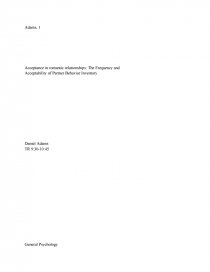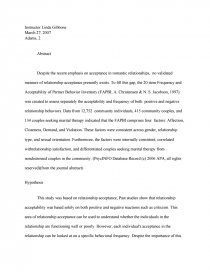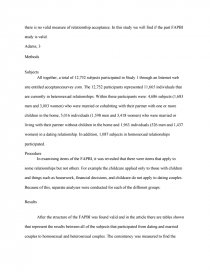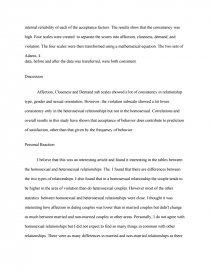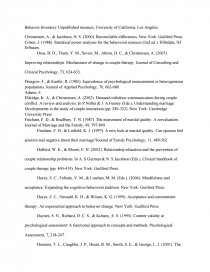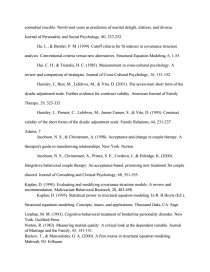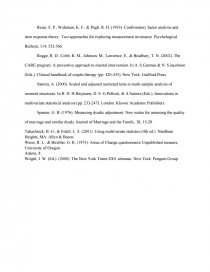Relationship Acceptanc Article Summary
Essay by review • December 29, 2010 • Research Paper • 1,857 Words (8 Pages) • 1,750 Views
Adams, 1
Acceptance in romantic relationships: The Frequency and
Acceptability of Partner Behavior Inventory
Daniel Adams
TR 9:30-10:45
General Psychology
Instructor Linda Gibbons
March 27, 2007
Adams, 2
Abstract
Despite the recent emphasis on acceptance in romantic relationships, no validated measure of relationship acceptance presently exists. To fill this gap, the 20-item Frequency and Acceptability of Partner Behavior Inventory (FAPBI; A. Christensen & N. S. Jacobson, 1997) was created to assess separately the acceptability and frequency of both positive and negative relationship behaviors. Data from 12,752 community individuals, 415 community couples, and 134 couples seeking marital therapy indicated that the FAPBI comprises four factors: Affection, Closeness, Demand, and Violation. These factors were consistent across gender, relationship type, and sexual orientation. Furthermore, the factors were internally consistent, correlated withrelationship satisfaction, and differentiated couples seeking marital therapy from nondistressed couples in the community. (PsycINFO Database Record (c) 2006 APA, all rights reserved)(from the journal abstract)
Hypothesis
This study was based on relationship acceptance, Past studies show that relationship acceptability was based solely on both positive and negative reactions such as criticism. This area of relationship acceptance can be used to understand whether the individuals in the relationship are functioning well or poorly. However, each individual's acceptance in the relationship can be looked at on a specific behavioral frequency. Despite the importance of this there is no valid measure of relationship acceptance. In this study we will find if the past FAPBI study is valid.
Adams, 3
Methods
Subjects
All together, a total of 12,752 subjects participated in Study 1 through an Internet web site entitled acceptancesurvey.com. The 12,752 participants represented 11,665 individuals that are currently in heterosexual relationships. Within these participants were: 4,686 subjects (1,683 men and 3,003 women) who were married or cohabiting with their partner with one or more children in the home, 5,016 individuals (1,598 men and 3,418 women) who were married or living with their partner without children in the home and 1,963 individuals (526 men and 1,437 women) in a dating relationship. In addition, 1,087 subjects in homosexual relationships participated.
Procedure
In examining items of the FAPBI, it was revealed that there were items that apply to some relationships but not others. For example the childcare applied only to those with children and things such as housework, financial decisions, and childcare do not apply to dating couples. Because of this, separate analyses were conducted for each of the different groups.
Results
After the structure of the FAPBI was found valid and in the article there are tables shown that represent the results between all of the subjects that participated from dating and married couples to homosexual and heterosexual couples. The consistency was measured to find the internal reliability of each of the acceptance factors. The results show that the consistency was high. Four scales were created to separate the scores into affection, closeness, demand, and violation. The four scales were then transformed using a mathematical equation. The two sets of
Adams, 4
data, before and after the data was transferred, were both consistent.
Discussion
Affection, Closeness and Demand sub scales showed a lot of consistency in relationship type, gender and sexual orientation. However, the violation subscale showed a lot lower consistency only in the heterosexual relationships but not in the homosexual. Correlations and overall results in this study have shown that acceptance of behavior does contribute to prediction of satisfaction, other than that given by the frequency of behavior.
Personal Reaction
I believe that this was an interesting article and found it interesting in the tables between the homosexual and heterosexual relationships. The I found that there are differences between the two types of relationships. I also found that in a homosexual relationship the couple tends to be higher in the area of violation than do heterosexual couples. However most of the other statistics between homosexual and heterosexual relationships were close. I thought it was interesting how affection in dating couples was lower than in married couples but didn't change as much between married and non-married couples in other areas. Personally, I do not agree with homosexual relationships but I did not expect to find so many things in common with other relationships. There were as many differences in married and non-married relationships as there were between relationships of different sexual orientation. I believe that this article found what it was looking for and answered it's question in the hypothesis. The FAPBI was a valid test and showed usable results.
Adams, 5
References
Bentler, P. M. (1995). EQS Structural Equations Program manual. Encino, CA: Multivariate Software, Inc.
Bradbury, T. N., Fincham, F. D., & Beach, S. R. H. (2000). Research on the nature and determinants of marital satisfaction: A decade in review. Journal of Marriage and the Family,
...
...
